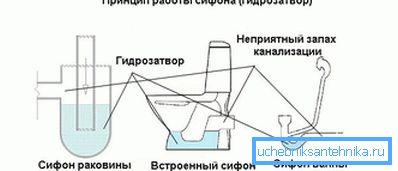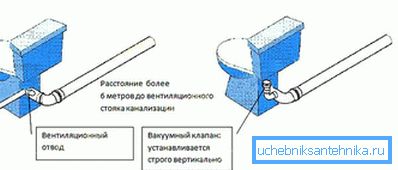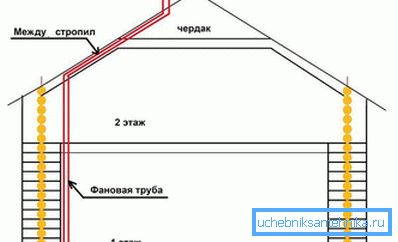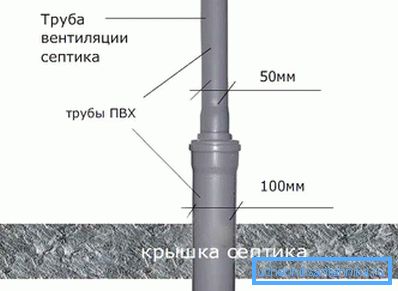Sewage ventilation in a private house
Without a funnel pipe or other devices, an unpleasant smell when breaking or drying the water seal will penetrate into the room, which will greatly worsen the comfort of living. How is the ventilation of sewage in a private house, and how to do it yourself, will be discussed in this article.
Why do we need ventilation and its types
If the house has risers with a diameter of more than 50 mm or in a building of more than one floor, it is necessary to equip the sewage ventilation system. The fact is that when a large amount of water is drained abruptly (for example, from a flush barrel of a toilet bowl), a vacuum is created in the pipes. As a result, water is drained from siphons. And if there is no obstacle for the smell (it is the water valve in the siphon that is an obstacle), then it will freely enter the room.

Even if your sewage system is equipped with pipes with a sufficiently large section and the flow of water does not completely block them (and therefore does not create a vacuum), the “aromas” can still get inside. This is due to the small size of the siphons. If you do not use the sanitary unit for 3-5 days, the water from it can simply evaporate. As a result, the odor barrier disappears.
All these troubles can fix the ventilation, which can be easily done with your own hands. It is of two types:
- ordinary fan pipe;
- using a vacuum valve.

Both options are often used in private homes and apartments. But the installation of a fan pipe is considered the most effective, and the vacuum valve plays the role of a supplement.
Fun pipe
Now we will tell about how to make ventilation of the riser using a fun pipe. This device is a continuation of the sewer riser, which is displayed outside. Many have seen small sections of pipes located on the roof of private houses, and they are the sewer ventilation.

The principle of their operation is quite simple. Warm air from the sewer rises up and goes out. As a result, a small vacuum is created inside the pipe, like traction in the stove, so air will flow from the room into the sewage system, and not vice versa.
Tip! As a rule, the fan pipe is displayed on the roof through a special shaft, which must be provided during the construction phase. If this is not done, then you can bring it horizontally to the side, through the wall.

When creating a sewer ventilation using a funnel pipe, the following recommendations and tips should be considered:
- the height of the funnel pipe must be at least 0.5 m from the roof level, and if the presence of an attic room is provided, then this value increases to 3 meters;
- the diameter of the hood should be equal to the diameter of the pipe riser;
- if you have several sewer risers, then they can be connected in the upper part and equipped with one fan pipe;
- It is not allowed to combine sewer ventilation with a chimney or with an exhaust ventilation system;
- It is undesirable to install a funnel pipe near windows and balconies, the smell can get inside the room. Better if between the hood and window openings will be at least 4 meters;
- if you have a multi-sloping roof, then it is not recommended to bring out the funnel pipe under the overhang of one of the ramps. In this case, it can simply be cut off or broken by snow.
- it is also not advisable to equip the top of the hood with a baffle. If this is done, then condensate may form, which will freeze in winter and will block ventilation (or reduce its effectiveness).

When arranging sewage ventilation, a funnel pipe is made (as a rule) of the same material as the riser. In fact, the hood will be a continuation of the horizontal pipe riser, derived on the roof. It should be borne in mind that the use of cast iron (namely, this material is still often found in sewers) is undesirable. The iron will start to rust and the pipe will just fall. It is better if the fan outlet is made of plastic.
Tip! Another recommendation is to warm the fun pipe. Of course, it will always be warmer than the surrounding air. But if in your region there are severe frosts, the insulation will not be superfluous. In addition, the insulation is simply necessary if the sewage system is used irregularly, for example, at the dacha.
Using a vacuum valve

There are situations when the creation of a conventional sewer ventilation system is impossible. What to do in this case? And in such a situation, you can find a way out - this is the use of a vacuum valve.
Such a device works according to the following principle:
- in the case there is a spring and a rubber seal;
- As soon as a vacuum is formed inside the riser (when a large amount of water is drained abruptly), the spring opens the seal. As a result, the air from the room enters the system and equalizes the pressure;
- after that, the spring returns to its place and prevents unpleasant smell from entering the room.

Of course, the vacuum valve is not a complete replacement of the funnel, but it does an excellent job with some of its functions. But if the water in the siphon dries out, such a device will not be able to help cope with the unpleasant smell.
Tip! The vacuum valve itself is installed at the top of the riser. In this case, the device should be in a warm room, where the temperature does not fall below zero.
If it is impossible to install the device on a riser, then it is mounted on any horizontal pipe. Some rules should be considered. Namely:
- the valve should be installed above the point of connection to the sewage system of the highest drain from the plumbing unit;
- if the room has a floor drain (for example, a shower stall), then the vacuum valve is installed at least 35 cm from the floor covering;
- the device must be able to free air intake (and its temperature must be above zero);
- the valve should be provided with free access for its repair and manual opening.
Creating external ventilation

If your house is equipped with autonomous sewage system, then you can use external ventilation for it. This is possible if there is a septic tank or other cleaning facility on the site. In this case, you can resort to two options for external ventilation:
- conclusion of the hood along the wall of the house. Externally, it will look like a drain, only the end of the pipe will be above the roof level. The hood is connected to the sewer outlet of the house, and is attached with clamps to the wall;
- the second option involves the installation of a ventilation pipe on the septic tank or other used sewage treatment plant. This is quite convenient, since the hood will be located far from the house (at least 5 m away), which eliminates the appearance of an unpleasant odor near the dwelling.
Installing external ventilation can help if the house does not have a sewer riser. Often this is found in small single-storey houses or in the suburban areas. When using these methods, it is advisable to install a vacuum valve indoors to improve the ventilation system.
See also:
How to connect fun pipes